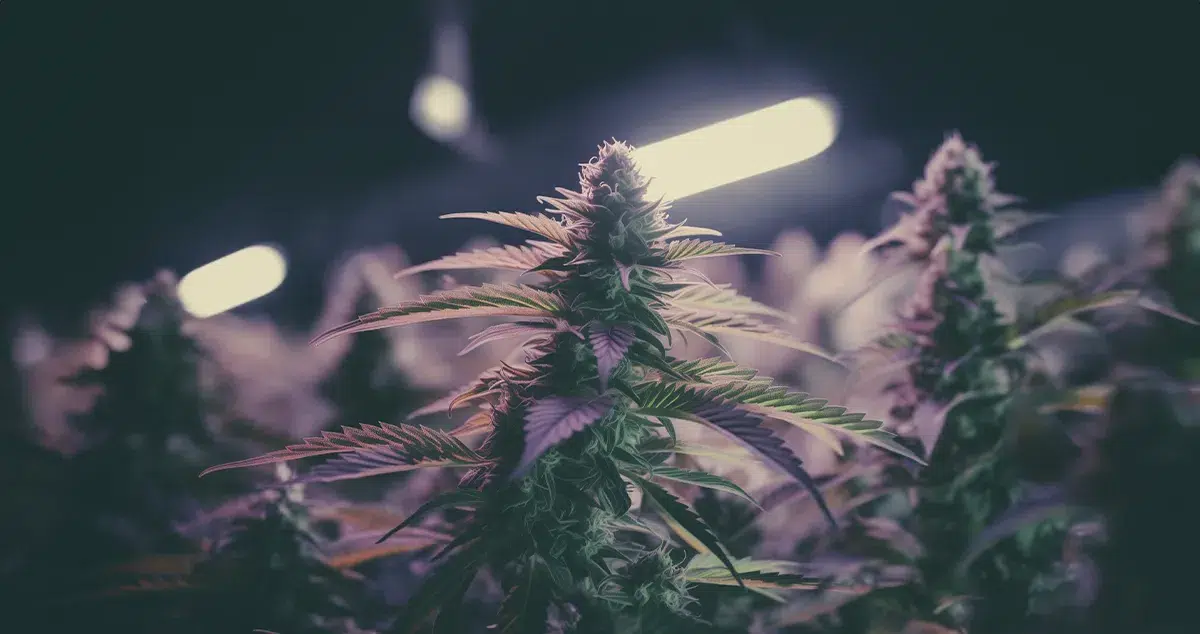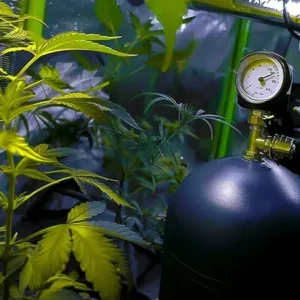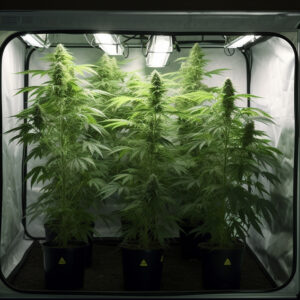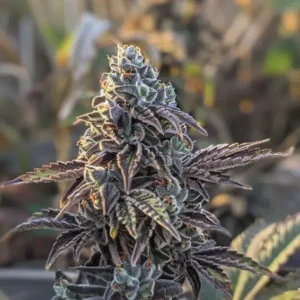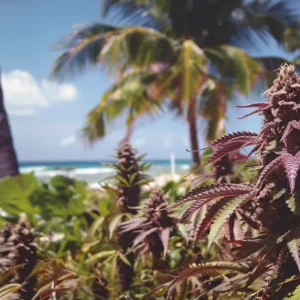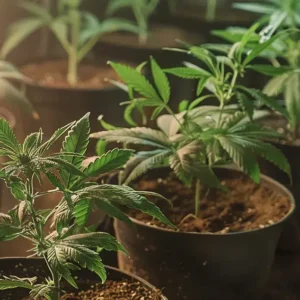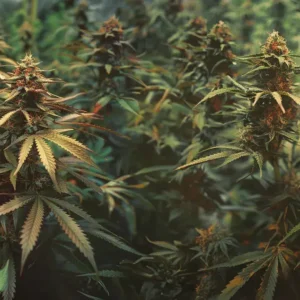TL/DR
- Determine the cubic volume of your grow space by calculating Length x Width x Height
- Filter any air coming from outdoors
- Oscillating fans are preferred for internal circulation
- Use Industrial options for larger spaces
- Carbon filters help keep your grow undetected by removing odors
In Part 1 of our grow room ventilation series, we covered the beneficial reasons “why” proper ventilation is important. Our journey continues as we look at the variables and necessary equipment for air ventilation when growing cannabis.
In Part 2, we focused on “how” to create proper airflow and the best ways to set up a ventilation system in several different grow room sizes.
Welcome to Part 3, where we will cover the equipment needed for your grow room ventilation system and help you select the right kit for your space.


Intake Systems: Getting Air Into Your Cannabis Grow Room
The journey that air takes through a grow space as part of a proper ventilation system begins with its arrival on the scene. Air is brought into the grow space by passive or active intake methods. You can use fresh air to regulate temperature, but most importantly, it replenishes carbon dioxide (CO2) levels. Increased CO2 is a huge advantage for your growing cannabis plants.
Part 2 of this series discussed the differences between passive and active air intake. To summarize, the size of the garden area and the cubic feet per minute (CFM) of the exhaust fan will determine the appropriate option for ensuring fresh air enters the grow room at the desired rate. An important consideration when deciding to use an active or passive intake is if you are trying to maintain negative or positive air pressure in the grow space.
You can find the cubic volume of a grow space by multiplying the length by width by height (LxWxH).
EXAMPLE: A 4ft(L) x 4ft(W) x 7ft(H) grow tent = 112 cubic feet (4×4=16 x 7= 112)
1.2m x 1.2m x 2.1m grow tent = 3 cubic meters
Is a Passive Intake Enough for Your Grow?
Air should be exchanged every 1-3 minutes. In the example above, we would want a fan with a rating of at least 112 CFM to exchange the air once per minute. There are other variables to consider when selecting the right CFM, but we will get into them later in the article.
For the majority of tent growers, passive air intake will work well. Exhaust fans with a high CFM rating move exhausted air at the desired rate, creating a suction that draws in fresh air from outside the tent. The passive intake method works well for areas 6ft x 6ft (183cm x 183cm) or smaller.
Do You Need an Active Intake Fan?
Growers using a large, open-room design often benefit from an active air intake. Exhaust fans alone may not be enough to passively introduce fresh air at the desired rate in big rooms. One benefit that may appeal to tent growers is the ability to use cool air from outside of the building for temperature mitigation inside.
If doing so, growers will need to balance the fans’ input vs. output rates to maintain their choice of negative or positive pressure within the tent. Growers using high-intensity discharge (HID) lighting systems often rely on cooler outdoor air to reduce the temperature in the grow tent.
Which Intake Fan is the Right One for Your Grow Room?
Intake fans come in many shapes and sizes, but the most important number to know is the CFM rating for the fan. Fresh Air actively pumped into a grow tent should enter at one of the lower ports (hot air inside should be exhausted from the top). Likewise, if you use an active air intake system for an open room configuration, be sure the air enters the grow space near ground level.


Although you could easily use a separate exhaust fan as an intake fan, it is usually overkill for tent growers, particularly those seeking to maintain negative air pressure. In large room configurations, having another exhaust fan, which, for this purpose, we would call an inline fan, would be the best solution for importing enough fresh air into the grow space.
It is best to purchase an inline fan with adjustable speed controls. Most models will have a rotary speed dial or multiple speed settings. Adjustability is a critical feature for an active air intake system; this series is a good example of an intake fan for grow tents. Use a dedicated inline fan to bring air in for spaces larger than 6ft x 6ft (183cm x 183cm). You can find our inline fan buyers guide here (LINK)
Do you Need an Air Intake Filter?
Even when drawing air from inside the house, having a filter is still a good idea; if you are drawing fresh air from outside the building, the answer is definitely yes. Filters help with air quality. They reduce the likelihood of pests and pathogens entering the grow area on the stream of imported air. Pests such as aphids, fungus gnats, spider mites, and thrips, amongst others, could be getting a free ride. Using air filters is essential to an effective integrated pest management (IPM) strategy.
With active air intake systems, there are many opportunities to introduce a filter. Having a filter between the source of the fresh air and the fans’ intake portis is always recommended. Ideally, the exchange site with the outside air has a filter before the air enters the ducting. Growers can also place a filter at the end of the ducting before the intake port on the fan. Additionally, placing another filter before the air enters the grow space is advised.
The number of filters and their thickness will reduce the CFM of your active air intake fan. Take this into consideration when purchasing your equipment. I recommend using High-efficiency particulate air (HEPA) filters. HEPA filters can block dust, pollen, mold, bacteria, and any airborne particles with a size of 0.3 microns.


Air Movement Inside Your Cannabis Grow Room
The mid-point in the ventilation journey involves what happens inside the grow space after the air has been drawn in but before it has been exhausted. Growers must have a way to push out pockets of stagnant air and mix the CO2-rich fresh air in and around the canopy. Good airflow promotes stronger cannabis plants and reduces the chances of mold. For this important task, we turn to circulation fans.


In the Grow Room, it’s all About the Fans!
Using 6” (15.25cm) clip fans is standard for tent growers. Clip fans, like this Spider Farmer model, attach to the tent poles and should have variable speeds. Preferably, these fans would be oscillating fans.
In grow areas of 4ft x 4ft (122cm x 122cm) up to 6ft x 6ft (183cm x 183cm), many growers use fans in opposite corners to ensure complete air flow coverage above the canopy. Where your air circulation occurs also matters. Ideally, there will be a steady flow of air above and below the canopy, but moving the air at the canopy level would be the priority.
When growing in open rooms, there is more available floor space, opening the potential to use larger floor fans. Still, it’s common to see multiple wall-mounted fans in rooms with wall-to-wall cannabis plants. Larger spaces require larger equipment; clip fans will not be effective in spaces larger than 6ft x 6ft (183cm x 183cm). Wall-mounted fans often range from 14in to 24in, and some come with an oscillation feature.
Most growers tend to only think about the plants when it comes to air circulation in their grow space, but air movement is also valuable for a few clever hacks. For example, we know that heat rises, and our grow lights put off a lot of heat. In cold winter months, fans can be placed above the lights, blowing the warm air downward to the canopy and root zones. Use the cooler air from the bottom of the tent in hot months and push it upwards.


Other Equipment You Might Need in the Grow Room
Part of the ventilation system for tent growers involves the room in which the tent is placed. This room is referred to as the lung room because this is where the tent passively receives air from. Air in the lung room is treated to create the right temperature and humidity levels inside the tent. Devices like dehumidifiers, air conditioners, window fans, heaters, etc., stir the air within the lung room. This helps to avoid stale pockets of air and keeps fresh CO2 circulating.
Growroom technology has advanced in the past decade. It has given us the ability to monitor conditions in the grow room without being there, and it has given growers the ability to control equipment remotely. Exhaust fans, active intake fans, and even the fans circulating air inside the grow tent can be preprogrammed to turn off and on when certain environmental parameters are reached. Before buying this equipment, check to see if your favorite company has this technology integrated into their ventilation products.
Exhaust Systems: Getting Air Out Of The Cannabis Grow Room
Many aspects of growing good cannabis are imperative. If you don’t water your plant, it will die. When you don’t have a grow light, the plant will not grow. If you don’t exhaust air from your grow space, you will have a hot, humid, CO2-depleted environment. At a minimum, the plants would severely suffer from heat stress and lack of CO2; most likely due to humidity, growers will be confronted with an unconsumable crop due to the nightmare of bud rot and mold.
Why do you Need an Exhaust Fan?
Exhaust fans get hot, moist, stale air out of the grow space. They are also part of the system to remove odors, but we’ll get to carbon filters soon. Exhaust fans should be able to exchange the air volume in a grow space once every 1-3 minutes. By exhausting stagnant, humid air at this rate, we create passive air intake caused by the fan’s suction. As it moves air out, new air must passively come in. This fresh air brings CO2 with it, and the plants love it.
You may be asking, what size exhaust fan do I need? Purchasing one with more CFM than needed is always recommended. Running a fan at lower speeds creates less noise/vibrations, but having an overpowered fan also allows growers to upgrade spaces and not need to buy new equipment. Earlier in this article, we covered how to determine the volume of the grow space. Once you have that number, you can look at CFM ratings for fans.
Exhaust fan sizes
The CFM of the fans listed below will be higher when used at full speed than the amount needed to exchange the air every minute in these examples, but below are my fan size recommendations compared to the common tent and room sizes:
| Tent size | Exhaust fan |
| 2ft x 2ft (61cm x 61cm) tent | 4in (10.16cm) exhaust fan |
| 3ft x 3ft (91cm x 91cm) up to 5ft x 5ft (152cm x 152cm) | 6in (15.25cm) exhaust fan |
| 6ft x 6ft (183cm x 183cm) up to 7ft x 7ft (213cm x 213cm) | 8in (20.32cm) exhaust fan |
| 8ft x 8ft (244cm x 244cm) | 10in (25.40cm) exhaust fan |
| 10ft x 10ft (305cm x 305cm) | 12in (30.48) exhaust fan |
Exhaust fans from popular companies like AC Infinity, Spider Farmer, Mars Hydro, etc, generally have a CFM rating of around 400 CFM for the 6in models.
Pro Tip: Manufacturers calculate CFM ratings using the highest fan setting without ducting or filters. This practice makes their numbers look more impressive. To account for this, always get a stronger fan than you need!
How do Carbon Filters Work?
Carbon filters pass untreated air through a layer of activated carbon, which is purified powdered charcoal. Those designed for cannabis growing will have a hollow space in the middle where suction from the exhaust fan pulls air from outside the filter inwards to be treated. Carbon particles are very porous and work by trapping smells or volatile organic compounds (VOCs) and not allowing them to pass through.
Fun Fact: A teaspoon of activated carbon has more surface area than an American football field. This is where the volatile compounds or VOCs (smells) get trapped, removing them from the exhaust stream.


Should You Be Pulling or Pushing Air Through the Carbon Filter?
Realistically, either way works, even if your configuration calls for one over the other. However, there are some advantages to pulling the air through the carbon filter instead of pushing it through. Pulling creates a more efficient exhaust system. It creates less wear on your fan’s motor as it pulls the air through the carbon filter, ultimately increasing your exhaust fan’s lifespan.
Additionally, suppose the fan is pushing more air into the carbon filter than it can actively treat in real time. In that case, there is a risk of smelly, untreated air escaping from the seals and seams of the carbon filter or ducting. Leaky, untreated air defeats the purpose of trying to maintain a stealthy cannabis grow room.


The Importance of Pre-Filters in Cannabis Cultivation
Most carbon filters will come with a cloth wrap that fits over it like a sock. This acts as a prefilter to catch larger particulates and avoids sending this material through the carbon filter and exhaust fan.
If you’ve ever worked with soil in a grow room with a white prefilter, you will see it turn a light shade of brown from stopping all of the airborne soil particulates. If not filtered over time, that particulate can prematurely wear out your exhaust fan. I prefer white to black prefilters because white lets you see how dirty and potentially clogged they are.


What Size Carbon Filter Do I Need for My Cannabis Grow?
When it comes to the size of your carbon filter, an important consideration is the size of the inlet port to the filter and the ducting you will be connecting to it. Ideally, you use a carbon filter with a 6in (15.25cm) port if you are using 6in (15.25cm) ducting. Or 8in (20.32) ducting with an 8in (20.32) port, etc.
Selecting the proper size of the carbon filter is more related to how often you will need to replace it than an actual measurement. There are “small boy” models, which are roughly 12in (30.48) tall. And all the way to the “tall boys” or floor filter models, which are 4ft (121.92cm) tall. For tent growing, hanging the carbon filter inside where the smelly air lingers is important. Growers usually select a 12in (30.48) to 18in (45.72cm) model. Those models typically offer 4-6 months of odor protection.
What is the Right Fan CFM for Carbon Filters?
Match the carbon filters’ CFM rating with the fans’ CFM rating, then purchase a carbon filter with an equal or higher CFM number than the exhaust fan. This will prevent the example given earlier of too much airflow entering the carbon filter and the potential of untreated air leaking out.
Other Considerations
A few things will reduce the CFM of your fan, and those need to be accounted for when determining the correct size fan for your garden area. Simply put, the longer your ducting and the more bends you have, the more the fan’s CFM is reduced. It helps to visualize or draw out your grow space plans to determine the potential configurations before purchasing.
In reality, with the short ducting runs commonly associated with grow tents, the overall CFM can be reduced by 4-7%. Using a prefilter will also lessen the CFM. However, not significantly enough to cause problems if the exhaust fan is overpowered for the space (as has been suggested).
Reduced CFM becomes more of a factor when ducting lengths exceed 25ft, which occurs more often with open room grow spaces or basement grows. With long ducting runs and multiple bends, the exhaust fan’s CFM can be reduced by 10%-25%. If you want to get precise with this equation, I suggest looking at Bernoulli’s equation. In the majority of cases, this loss of CFM can be overcome by purchasing a powerful fan. Get one with more than enough CFM to exchange the air every 1-3 minutes.
How To Control the Odour Coming Out of Your Cannabis Grow
Keeping the smell of your cannabis grow contained is extremely important for the majority of cannabis growers. Believe it or not, even vegging marijuana plants have a distinctive smell. Whether cannabis plants are in the vegetative or flowering stage, neither smell like a smoked flower. This may also be undesirable, so growers must take steps to prevent smells from escaping their grow at every stage of growth.
Negative Pressure for Better Odor Control
Using negative air pressure is an important first step in fighting odor. We go into depth on negative vs positive air pressure in Part 2 of this series, but negative air pressure means that air is leaving the tent faster than it is being pulled or pushed in. A visual indicator of this is when you zip your tent up at lights out, do the side walls suck inwards? That is a result of negative pressure.
Negative pressure allows all the air within the grow tent to enter through the carbon scrubber before being exhausted. Because air leaves faster than it comes in, no untreated smelly air can linger and escape through the seams or open vents on the grow tent.
Should The Carbon Filter be Inside or Outside the Grow Room?
Most carbon filters for cannabis are designed so that if you want to place the filter before the fan (as suggested), it must be inside the tent. However, an exhaust fan can be (but doesn’t have to be) located outside the grow tent. And then connected to the carbon filter via ducting if vertical space in the tent is an issue.
Untreated air enters through the vent holes of the carbon filter. It exits through the dedicated port, which is connected to ducting and the exhaust fan. The suction of the exhaust fan is the catalyst for air entering and passing through the carbon filter. Scents are removed from the air as the air is drawn in through the vent holes and passed through the inner layer of carbon pieces.
5 Pro-tips for Better Odor Control in your Cannabis Grow
- Start by having negative air pressure in your grow space, and use a carbon filter.
- It is possible to have a carbon filter inside the tent placed inline before the exhaust fan. And another carbon filter outside the tent placed after the exhaust fan for twice the amount of odor removal. Doing this will reduce the CFM of the fan by at least 10%. This causes excess wear on the motor, but for some growers, this extra step helps them sleep better.
- Growers become nose-blind to the smells very quickly. Be sure to change your filters at a regularly scheduled interval instead of waiting until the plants can be smelled outside of the grow area. Changing your carbon filter when the grow space is empty is easiest. Plan accordingly.
- The higher the exhausted air, the better. Even after the air has been through a carbon filter, exhausting the air at street level carries a higher detection risk than venting out of an attic vent, upper-floor window, or chimney.
- Like most of the other important gear for growing cannabis, having an extra carbon filter ready to go can be a good idea. Waiting for a new carbon filter to arrive in the middle of flowering can be a nervous few days or weeks. Who knows if the place you order from has them in stock?
Conclusion
Proper air circulation can be complex. The journey that air takes through a ventilation system has many stages. It serves many purposes, and involves more than a few pieces. When planning for your equipment, the appropriate size directly relates to the volume of your space. You can use simple mathematical formulas to determine the volume of your grow space. Use that information and it will guide your purchasing decisions.
This article details the proper ventilation process and the equipment used in a grow room ventilation system. We covered how air flow has three distinct stages: intake, circulation, and exhaust. Equally important, we covered how to remove grow room odors using carbon filters. It is always better to err on the side of excess when buying equipment or employing methods to keep your garden undercover. Overpowered is better than to be underpowered. When growing some pleasantly stanky genetics from ILGM, keeping these principles of air movement and odor removal in mind can be beneficial. To be sure you are up on the rest of your grow game, download Robert’s Grow Bible. This gives you the complete information to get you from seed to harvest. What are your preferred methods for masking odors and moving air? Do you use active air intake? Let us know in the comments. Happy gardening!
